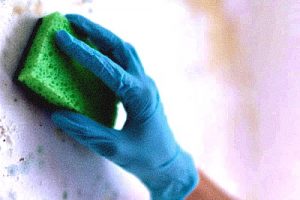 Mould can be found in so many places around the house – mainly the bathroom, basement, laundry rooms and more. Basically any place where the levels of humidity are high. What is more, it can grow on furniture, mattresses, cupboards and appliances. There are different types of mould and depending on which one you got, cleaning can be super easy or not so much.
Mould can be found in so many places around the house – mainly the bathroom, basement, laundry rooms and more. Basically any place where the levels of humidity are high. What is more, it can grow on furniture, mattresses, cupboards and appliances. There are different types of mould and depending on which one you got, cleaning can be super easy or not so much.
If you are having a large area that is mouldy, you may need to call a professional cleaning company to take care of it. They can come test it and remove it in a safe way which will prevent it from coming back soon after. It is important to turn to a professional in such a situation because there are a number of dangerous types of mould that should be specially treated, in order to not cause a threat.
For smaller areas that grow mould you can easily find treatment yourself. There are plenty of products that will help you get rid of mould, however you should make sure to follow some safety guidelines. Some of them are very powerful and will rid you of mould in no time. However, whenever you want to find a safer, more natural way – go for vinegar! Distilled white vinegar and cleaning vinegar are safe and less toxic for both the environment and humans. Whenever picking vinegar to use, make sure the acetic acid levels are higher than 4.2%. Distilled white vinegar, for example, contains around 5 percent acetic acid and 95 percent water.
Vinegar is good for removing mould but is slow acting. It is not going to remove all mould right away and some of the discolouration and stains left behind might stay and require additional scrubbing.
What is important to remember is that mould should be treated as soon as it is discovered. Small colonies can easily turn into large ones and take over a whole wall. When removed on time, mould would stay away for longer.
In the following lines, we will show you exactly how to use vinegar against mould.
- It is important to wear protective gear
Some types of mould may cause toxic reactions so you want to be safe. Protective eyewear, an N-95 mask, and rubber gloves should be worn when cleaning. Wearing old clothes will also help. After you are done cleaning, toss them straight in the washer to prevent mouldy spots transferring to other parts of the house. - Make sure there is proper air flow
It is of crucial importance that you open doors and windows while cleaning mould. A good amount of air flow will not allow the toxic fumes to stay around and what is more, it will help the mould patch to dry out faster. - Spray the vinegar on
Pour undiluted vinegar into a spray bottle and spray it on the surface. You should let it sit for at least one hour before you continue with the other steps. - Rinse it out
Take a sponge and make it damp. Wipe the surface while frequently rinsing the sponge. If you are wiping a vertical surface, make sure you start from the top and work your way down. That way you will catch any drips. - Inspect for stains and discolouration
If the mould left grout or other finishes discoloured, you will need to use oxygen based bleach. This product will not kill mould spores but will be extremely effective against stains. - Treat discolouration with oxygen bleach
Mix the bleach with some water. Do that in a bucket and stir well to dissolve the powder. Apply the solution to the stained area with a sponge or a nylon-bristle brush, depending on the surface you are working with. For example, the brush is best used on grout. Let it sit for 30 minutes before rinsing it with clean water. - Dry the surface
Pat the area down with a dry cloth ( if very wet), then allow it to air dry. Leave the windows and doors open, it will speed up the process.
Vinegar is great for removing mould from appliances such as refrigerators, dishwashers and washing machines. What is more, it can be used on clothes and accessories as well. When treating such items, take them outside and brush off the mould there to prevent spores from spreading around your house. Check the labels to see what the recommended way of washing is. Use the highest allowed temperature and add vinegar to your washing machine load. If the stain is still there, use oxygen bleach (when possible) to remove any remains.
If you have any leather goods that are mouldy, rub them with vinegar. The mould will fall off but you should remember touse leather cleaner and polish after.
Here are some ways to reduce the amount of mould in your house.
- Repair plumbing leaks
- Use a dehumidifier and HVAC systems to reduce the amounts of moisture
- Install moisture barriers in basements
- Clean mould-prone areas frequently
- Keep windows open when warm outside
